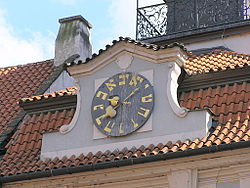Hebrew numerals
The system of Hebrew numerals is a quasi-decimal alphabetic numeral system using the letters of the Hebrew alphabet.
| Numeral systems by culture | |
|---|---|
| Hindu–Arabic numerals | |
| Western Arabic Eastern Arabic Khmer |
Indian family Brahmi Thai |
| East Asian numerals | |
| Chinese Suzhou Counting rods |
Japanese Korean |
| Alphabetic numerals | |
| Abjad Armenian Cyrillic Ge'ez |
Hebrew Greek (Ionian) Āryabhaṭa |
| Other systems | |
| Attic Babylonian Coptic Egyptian Etruscan |
Mayan Roman Urnfield |
| List of numeral system topics | |
| Positional systems by base | |
| Decimal (10) | |
| 2, 4, 8, 16, 32, 64 | |
| 1, 3, 9, 12, 20, 24, 30, 36, 60, more… | |
In this system, zero does not have a place, and the number values for each letter are added together. Each unit (1, 2, ..., 9) is assigned a separate letter, each tens (10, 20, ..., 90) a separate letter, and each hundreds (100, 200, ..., 900) a separate letter.
Main table
Hebrew has masculine and feminine ways of saying the words. For just counting, feminine is used. Otherwise, the gender is used (ex. two boys, two girls).
| Decimal | Hebrew | Glyph | Name | |
|---|---|---|---|---|
| Masculine | Feminine | |||
| 0 | N/A | efes | ||
| 1 | Aleph | א | echad | achat |
| 2 | Bet | ב | shnayim | shtayim |
| 3 | Gimel | ג | shlosha | shalosh |
| 4 | Dalet | ד | arba'a | arbah |
| 5 | He | ה | chamisha | chamesh |
| 6 | Vav | ו | shisha | shesh |
| 7 | Zayin | ז | shiv'a | sheva |
| 8 | Het | ח | shmonah | shmoneh |
| 9 | Tet | ט | tish'a | tayshah |
| 10 | Yod | י | assara | eser |
| 20 | Kaph | כ | esrim | |
| 30 | Lamed | ל | shloshim | |
| 40 | Mem | מ | arba'im | |
| 50 | Nun | נ | chamishim | |
| 60 | Samekh | ס | shishim | |
| 70 | Ayin | ע | shiv'im | |
| 80 | Pe | פ | shmonim | |
| 90 | Tsadi | צ | tish'im | |
| 100 | Qoph | ק | me'a | |
| 200 | Resh | ר | matayim | |
| 300 | Shin | ש | shlosh meot | |
| 400 | Tav | ת | arba meot | |
| 500 | Tav Qoph or Kaph Sophit | ת"ק or ך | chamesh meot | |
| 600 | Tav Resh or Mem Sophit | ת"ר or ם | shesh meot | |
| 700 | Tav Shin or Nun Sophit | ת"ש or ן | shva meot | |
| 800 | Tav Tav or Pe Sophit | ת"ת or ף | shmone meot | |
| 900 | Tav Tav Qoph or Tsadi Sophit | תת"ק or ץ | tsha meot | |
- The number is first, then the noun (ex. shlosha yeladim), except for number one where it is reversed (ex. yelad echad).
- The number two is special. Shnayim (m.) and shtayim (f.) become shney (m.), and shtey (f.) when describing the number of some noun.
- Mixed groups are always addressed as male, which is the case with all Hebrew.
- Objects are either male or female (ex. a book (sefer) is male).
Hebrew Numerals Media
The lower clock on the Jewish Town Hall building in Prague, with Hebrew numerals in counterclockwise order
Early 20th century pocket watches with Hebrew numerals in clockwise order (Jewish Museum, Berlin)

